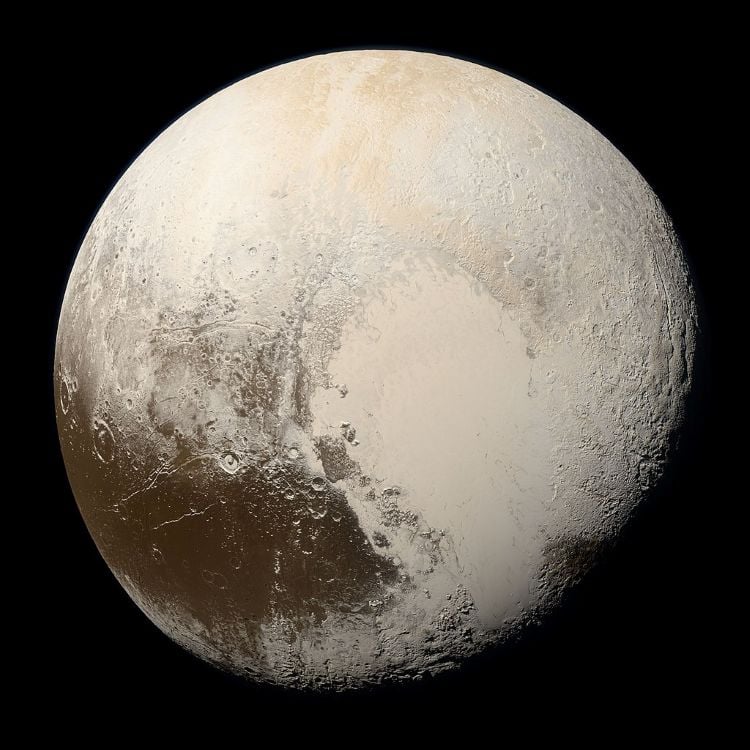Science
Researchers Uncover Evidence of Cryovolcanism on Pluto

A recent study published in *The Planetary Science Journal* has revealed significant evidence of cryovolcanism on Pluto, specifically within the Kildaze caldera in the dwarf planet’s Hayabusa Terra region. Researchers aimed to investigate how geological activity continues on Pluto despite its considerable distance from the Sun. This research could provide valuable insights into the current state of Pluto’s geological activity.
To conduct their investigation, the team analyzed images captured by NASA’s New Horizons spacecraft during its historic flyby in July 2015. They compared these images with other cryovolcanic sites on Pluto, such as Virgil Fossae and Viking Terra, and examined analog sites on Earth, including the Yellowstone caldera and Valles Caldera, as well as on Mars, like the pit craters in Noctis Labyrinthus.
Utilizing digital elevation models and 3D visualizations, the researchers sought to determine the origins of the water ice present in Kildaze. Their findings suggest that the water ice is approximately a few million years old, significantly younger than Pluto itself. The study concludes that Kildaze likely functions as a cryovolcano, with a history that includes one or more eruptions ejecting around 1,000 km³ of cryolava.
Cryovolcanism, characterized by the eruption of icy “magma” instead of molten rock, has been observed on various celestial bodies, including Ceres, Europa, and Enceladus. Potential sources of this phenomenon involve external factors like crater impacts or tidal heating from interactions between celestial bodies, as well as internal heat generated through radioactive decay.
What distinguishes Pluto’s case is its position as the most distant known planet from the Sun, raising questions about the driving forces behind its geological activity. Scientists continue to debate whether Pluto’s internal heat is due to tidal heating from its largest moon, Charon, or remnants of heat from its formation billions of years ago. A study published in *Icarus* in March 2022 proposed that interactions with Charon contribute significantly to Pluto’s internal heating.
While New Horizons remains the only spacecraft to have visited Pluto, scientists are eager to analyze the data it collected. Future missions to Pluto have been proposed, including an innovative orbiter-lander combination powered by a fusion reactor, which could potentially reach Pluto in just four years. This contrasts sharply with the nine years it took for New Horizons to arrive.
As researchers sift through the wealth of information from the New Horizons mission, they remain hopeful that new discoveries regarding Pluto’s cryovolcanic activity will emerge in the coming years. The quest to understand the geological dynamics of this distant dwarf planet continues, revealing the fascinating complexities of our solar system.
-

 Science2 months ago
Science2 months agoInventor Achieves Breakthrough with 2 Billion FPS Laser Video
-

 Health2 months ago
Health2 months agoCommunity Unites for 7th Annual Into the Light Walk for Mental Health
-

 Top Stories2 months ago
Top Stories2 months agoCharlie Sheen’s New Romance: ‘Glowing’ with Younger Partner
-

 Entertainment2 months ago
Entertainment2 months agoDua Lipa Aces GCSE Spanish, Sparks Super Bowl Buzz with Fans
-

 Health2 months ago
Health2 months agoCurium Group, PeptiDream, and PDRadiopharma Launch Key Cancer Trial
-

 Top Stories2 months ago
Top Stories2 months agoFormer Mozilla CMO Launches AI-Driven Cannabis Cocktail Brand Fast
-

 Entertainment2 months ago
Entertainment2 months agoMother Fights to Reunite with Children After Kidnapping in New Drama
-

 World2 months ago
World2 months agoR&B Icon D’Angelo Dies at 51, Leaving Lasting Legacy
-

 World2 months ago
World2 months agoIsrael Reopens Rafah Crossing After Hostage Remains Returned
-

 Business2 months ago
Business2 months agoTyler Technologies Set to Reveal Q3 Earnings on October 22
-

 Health2 months ago
Health2 months agoYouTube Launches New Mental Health Tools for Teen Users
-

 Health2 months ago
Health2 months agoNorth Carolina’s Biotech Boom: Billions in New Investments









